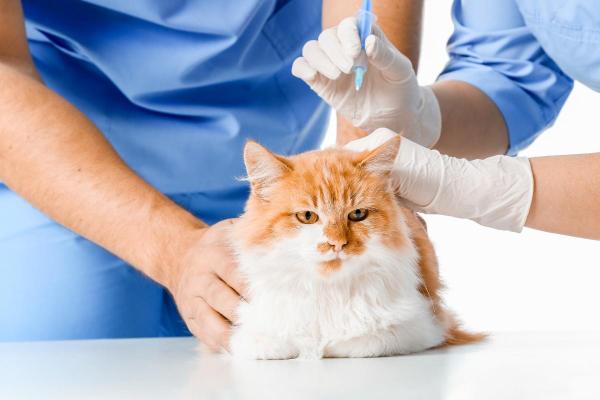Leukemia Virus Vaccine for Cats



See files for Cats
Vaccinations for cats are the best method of disease prevention for various infectious agents. While a minority are used to prevent bacterial agents, the majority of feline vaccinations are to prevent viral diseases. One of the most virulent and deadly is the feline leukemia virus (FeLV), a retrovirus which seriously depletes the immune system of cats. Although the disease itself can cause leukemia, lymphoma and severe anemia, it is not usually the direct cause of death. The lowering of the immune system makes the cat vulnerable to infections which they would otherwise be able to fight easily. There are different subgroups of the feline leukemia virus, each of which has their own symptomology and prognosis. Feline leukemia virus vaccines are designed to protect against infection.
Some cat guardians are concerned about vaccinations and potential harm they can cause their cat. This is why AnimalWised looks at the leukemia virus vaccine for cats side effects. We see how it works and why the reward vastly outweighs the risk.
- What is the leukemia vaccine for cats?
- Is the feline leukemia vaccine mandatory?
- When is the leukemia vaccine for cats administered?
- How often should a cat be vaccinated against feline leukemia virus?
- Can a vaccinated cat get leukemia?
- How much does the leukemia virus vaccine for cats cost?
- Side effects of the leukemia vaccine in cats
What is the leukemia vaccine for cats?
The feline leukemia vaccine protects against the disease caused by the feline leukemia virus (FeLV). This is a single-stranded RNA retrovirus that has the ability to integrate into the genome of the cells of small felines. It can remain latent in the genome without causing symptoms for long periods of time until some reactivation occurs. Some cats may never have reactivation, but the risk will remain for life once the cat is infected.
Diseases which can directly lead from the FeLV include an acute form of feline leukemia which can quickly kill our cat, as well as lymphoma and severe anemia. There are different subgroups of the virus, but only the FeLV subgroup A is contagious between felines. This subgroups has a high virulence and can easily spread through close contact, especially during mutual grooming.
While the main route of infection is direct through secretions such as saliva, it can be passed on through wounds, contaminated needles or even the placenta from mother to kittens. This virus tropic behavior toward the blood cells of the hematopoietic system, seeking to reach the bone marrow.
Some of the main disorders which can be spread via the feline leukemia virus include the following:
- Anemias
- Platelet disorders
- Leukopenia (decrease in white blood cells)
- Cancers such as leukemia and lymphoma
The FeLV also leads to immunosuppression which predisposes cats to various health disorders, including the following:
- Opportunistic bacterial, viral and fungal infections
- Gingivitis
- Toxoplasmosis
- Rhinotracheitis
- Pneumonia
- Skin disorders
- Many others
Other problems that this virus can cause in cats include neurological impairment, immune-mediated diseases, eye disorders and enterocolitis. It can also cause infertility or endometritis in females. Pregnant cats can experience resorption or miscarriage of fetuses as a result of infection from feline leukemia virus.
Learn about the life expectancy of a cat with leukemia in our related article.
Is the feline leukemia vaccine mandatory?
No, the feline leukemia vaccine is not mandatory for our cats. It is a non-core vaccine, meaning its use is usually at the discretion of a veterinarian. Despite not being a core vaccine, it is highly recommended due to the potentially lethality of the virus. It is especially recommended for cats with outdoor access as they are more likely to come in contact with infected individuals. Vaccination schemes are often implemented in feral cat colonies to stop its spread.
Feline leukemia is a disease that can be very serious for our felines. The practice of vaccination can help prevent the worst forms of the disease. Even if transmission is relatively unlikely, many vets will recommend its use as a precaution. This is because the risks of severe side effects are very low. The use of the vaccine for feline leukemia is highly recommended, especially in cats with a higher risk of being infected.
If you want to learn more about core vaccinations in cats, take a look at our article asking what is the triple vaccine for cats?

When is the leukemia vaccine for cats administered?
When you adopt a kitten into the home, it is important to know their vaccination status. This is sometimes not possible if the cat has been rescued after being abandoned. However, they should still be vaccinated as there is little chance of adverse effects even if they have had the FeLV vaccine before. As soon as possible, we should take the cat to a veterinarian for their first checkup, during which a vaccination schedule will be established.
The primary vaccination (first vaccination) against the feline leukemia virus should begin when our kittens are 8 weeks old. A booster should be given at 4 weeks and 12 weeks. If we have not vaccinated the kitten at 8 weeks old, it should be vaccinated only at 12 weeks old and then revaccinated at the age of one year old. After initial vaccinations and boosters, revaccination usually takes place every 2-3 years, although this is at veterinary discretion.
How often should a cat be vaccinated against feline leukemia virus?
Feline leukemia vaccine doses should be repeated at intervals of two to three years at most in domestic cats which at risk of contracting the virus. These include cats with access to the outdoors. Indoor cats with little risk of contact with other cats may not need to be vaccinated once their viral status has been determined.
Learn about how an indoor cat can get fleas with our related article.
Can a vaccinated cat get leukemia?
Yes, a vaccinated cat can become infected with feline leukemia. This is because the FeLV vaccine does not protect 100%. However, it does provide 80-90% protection against the spread of the virus. Due to the virulence of the disease, cats which are positive for FeLV will need to be separated from other cats for life. This may require them being kept indoors, even if they have previously had outdoor access.
How much does the leukemia virus vaccine for cats cost?
The cost of any vaccine will depend on various factors, especially the country in which it is being administered. This is because veterinary health care pricing varies according to the market and the governance of the country.
In the USA, average pricing can be broken down as follows:
- Primary FeLV vaccine: $25–$45.
- 4 week booster: $25–$45.
- Biennial or triennial booster: $25–$45.
As you can see, the total cost of lifetime vaccination can differ. Many cats will get less boosters as they get older. This is both due to their immunity status, as well as having less risk of infection.

Side effects of the leukemia vaccine in cats
Like all vaccines, the feline leukemia vaccine can cause side effects immediately after inoculation in our cats. These are responses from the immune system which is being stimulated by the vaccine. They do not always occur, but they are usually mild if they do. They include:
- Local reaction at the injection site (itching, redness or increased sensitivity)
- Slight increase in body temperature (low-grade fever)
- Lethargy
- Temporary loss of appetite
These side effects will subside after 24-48 hours. Not all cats will experience them, but they may also have effects of the stress triggered by going to the veterinary clinic. Only in very rare cases will serious adverse leukemia vaccine in cats side effects occur. These will likely be one of two possible outcomes:
- Vaccine-associated sarcoma (VAS): although rare, this is a serious form of feline cancer that can develop at the injection site. Modern vaccines use technology which greatly reduces the risk of inflammation and subsequent cancers.
- Allergic reaction: this only occurs in cats which are sensitive to anything contained in the injection. This can include swelling or even breathing difficulty. This is one of the reasons why cats are monitored at the clinic for a short period after vaccination. Learn about anaphylactic shock in cats with our related article.
We must stress the safety of this and other vaccinations in cats. While there is some risk of side effects, the risk of serious side effects is minimal. The benefit of protection against an often-fatal disease such as those caused by the feline leukemia virus mean the benefits outweigh the risk.
Learn more with our article explaining the side effects of all vaccines for cats.

This article is purely informative. AnimalWised does not have the authority to prescribe any veterinary treatment or create a diagnosis. We invite you to take your pet to the veterinarian if they are suffering from any condition or pain.
If you want to read similar articles to Leukemia Virus Vaccine for Cats, we recommend you visit our Vaccination category.







